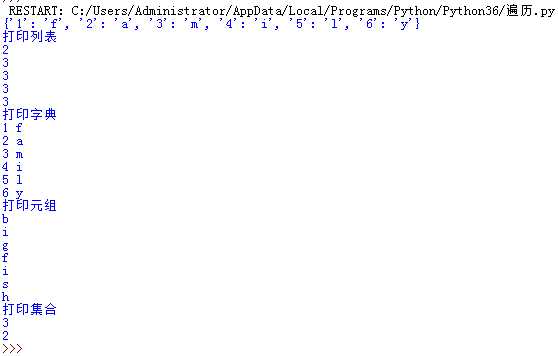标签:分割 大小 速度 字符 不能 item 分解 占用 一个
1.字典实例:建立学生学号成绩字典,做增删改查遍历操作。
dict={‘001‘:‘66‘,‘003‘:‘77‘,‘006‘:‘88‘,‘009‘:‘99‘}
print(‘学生学号成绩:‘,dict)
dict[‘007‘]=96
print(‘增加学号为007的学生的成绩为96:‘,dict)
dict.pop(‘001‘)
print(‘删除学号为001的学生的记录:‘,dict)
dict[‘007‘]=100
print(‘修改学号为007的学生的成绩为100:‘,dict)
print(‘查找学号为002的学生的记录:‘,dict.get(‘002‘))
运行结果如图:

2.(1)列表,元组,字典,集合的遍历。
nums=(‘123456‘) words=(‘family‘) list=list(‘23333‘) tu=tuple(‘bigfish‘) s=set(list) dict=dict(zip(nums,words)) print(dict) print(‘打印列表‘) for i in list: print(i) print(‘打印字典‘) for j in dict: print(j,dict[j]) print(‘打印元组‘) for i in tu: print(i) print(‘打印集合‘) for i in s: print(i)
运行结果如图:

(2)总结列表,元组,字典,集合的联系与区别。
答:list是一种有序的序列,正向递增、反向递减序号。可以随时添加和删除其中的元素,没有长度限制,元素类型可以不同。
tuple和list非常类似,都是有序的序列。但是tuple一旦初始化就不能修改。
dict使用键-值(key-value)存储,key是不可变的对象。插入和查找速度快,不会随着key的增加而变慢,需要占用大量的内存。dict是用空间换取时间的一种方法。
集合(set)则是一组key的无序集合,但是它只包含key,key值不能够重复,并且需要先创建一个List作为输入集合才能继续创建set。
3.英文词频统计实例
w =‘‘‘London bridge is falling down, falling down, falling down. London bridge is falling down, my fair lady . Build it up with iron bars, iron bars, iron bars. Build it up with iron bars, my fair lady. Iron bars will bend and break , bend and break, bend and break. Iron bars will bend and break, my fair lady. ‘‘‘ w = w.lower() for i in ‘,.‘: w=w.replace(i,‘ ‘) songs=w.split(‘ ‘) print(‘分割替换后的歌词为: ‘+str(songs)) ##定义字典# d={} #写入字典# di=set(songs) for i in di: d[i]=0 for i in songs: d[i]=d[i]+1 print("单词列表:"+str(d.items()))

标签:分割 大小 速度 字符 不能 item 分解 占用 一个
原文地址:http://www.cnblogs.com/Green-/p/7596050.html